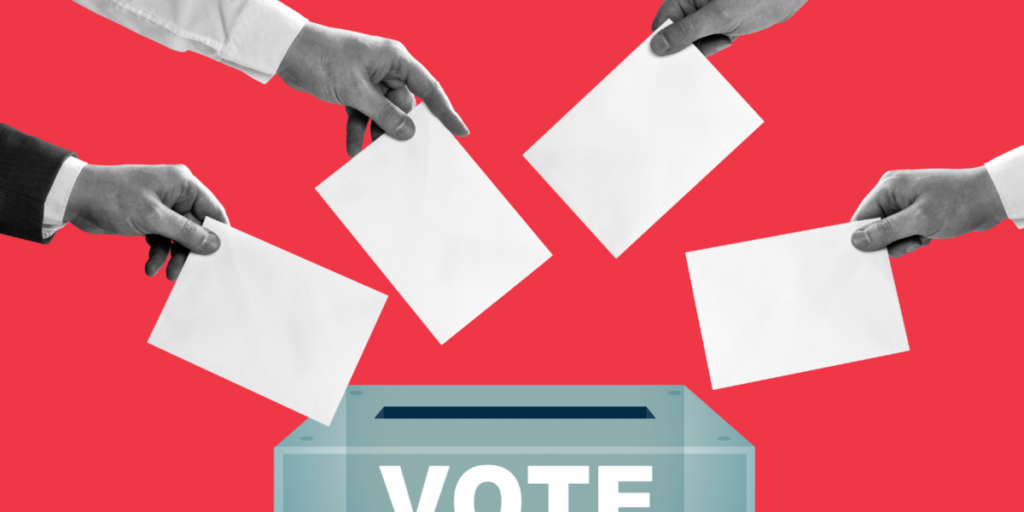This year, more than 60 countries are holding national elections. With that, 2024 is considered to be an “exceptional election year”, perhaps the most important in history. It’s estimated that nearly 2 billion voters, or around 25% of the world’s population, will take part in the ballots .
Crucial and highly anticipated elections will be held in densely populated countries such as the USA, Mexico, India, and Indonesia, to name but a few. The European Union’s parliamentary elections in June are the most significant vote of the year in Europe. And the UK will also hold its general election on July 4, with the Labour Party set to return to power after 14 years of Conservative governance.
At Onclusive, we’re scrutinising these elections in both traditional and social media to draw out lessons and insights. This data is collected via our social media listening, media monitoring, and media measurement tools.
I. Conversations about elections on social media: a comparison of 4 major elections
Let’s take a look at the US Elections (November 2024), the European Elections, the Mexican Elections (June), and the UK Elections (July).
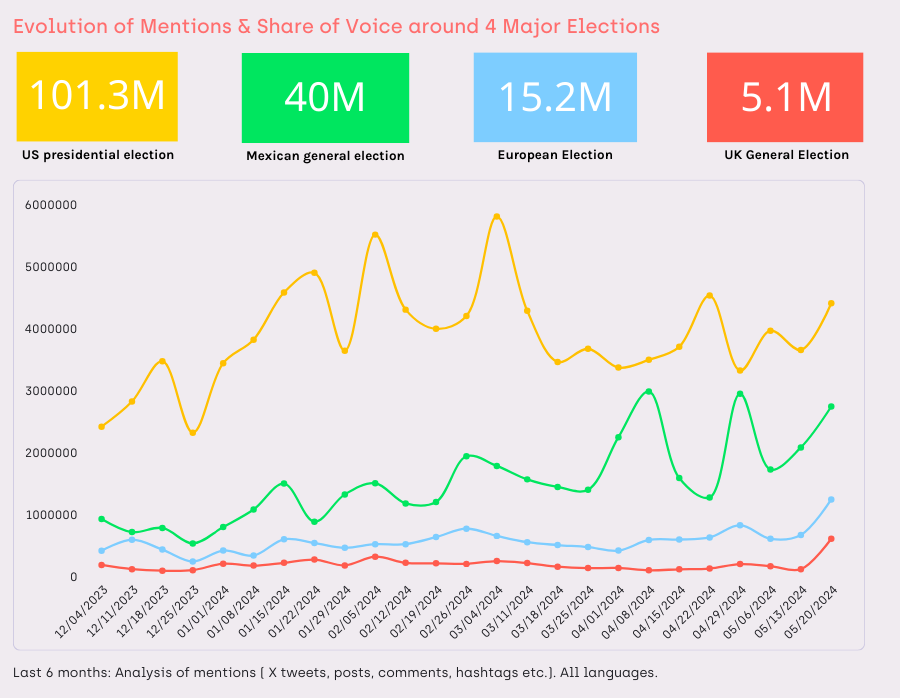
Interest in the 2024 US elections dominates social media discussion overall. With over 100 million mentions in the last 6 months, the US presidential election is generating an incredible number of messages on social media, in numerous languages. Topics including foreign policy, border control, and the two candidates – Trump and Biden – are the most discussed.
The popularity of the US election across global social media is unsurprising. US leaders and their policies inevitably create an international impact; whether economic and/or geopolitical. International tensions and conflicts, particularly in Ukraine and the Middle East, make North American politics a focus of attention for many countries. In addition, Trump’s highly divisive personality, his liabilities surrounding the storming of the Capitol, and his numerous legal setbacks accentuate the volume of messages.
The European elections from June 6 – 9 have generated the fewest mentions: “only” 15.2 million, which is very low considering the 27 countries involved and the 358.9 million Europeans entitled to vote. However, since the beginning of April, as the televised debates between candidates have multiplied, comments on social networks have increased by 17%.
By comparison, the UK’s General Election, fixed for July 4, generates much more interest proportionately. On May 22, the British Prime Minister, Rishi Sunak, called a general election earlier than expected. Conversations have since reached 2 million mentions, with a year-to-date total of over 5 million mentions. The discussions often revolve around the question: Why did the Prime Minister call an election he’s almost certain to lose? For months, polls have placed Sunak’s Conservative Party well behind the opposition Labour Party. And as things stand, Labour leader, Keir Starmer, should not only win power, but also gain a huge parliamentary majority.
In Mexico, the General elections on June 2 attracted over 39 million mentions (90% of which were in Spanish). Beyond the 3 candidates, social media messages concern a large number of Mexican institutions. The stakes are high. These elections include:
- The election of the president
- Legislative elections renewing both chambers
- State elections renewing governors in 8 of the 31 states
- Municipal elections.
Let’s take a closer look at each of these.
II. Focus on 4 elections: media monitoring and social listening
A. Mexican general elections 2024 (June 2)
1. Candidates
The two leading candidates were:
- Claudia Sheinbaum (Sigamos Haciendo Historia), scientist and former mayor of Mexico City
- Xóchitl Gálvez (Fuerza y Corazón por México), outspoken former senator and technology entrepreneur.
Ms. Sheinbaum was a favorite in the polls not least because of her commitment to pursuing the agenda of the current president, Mr. López Obrador.
Jorge Álvarez Maynez will also be running for the Citizens’ Movement party. Opinion polls didn’t favor him over his competitors, but he tried to attract young voters and people who feel frustrated by the current president’s Morena party and the opposition.
The latest polls, as of May 28, showed the following breakdown of voting intentions: Claudia Sheinbaum: 53%, Xóchitl Gálvez: 36%, and Jorge Álvarez Máynez: 11%.
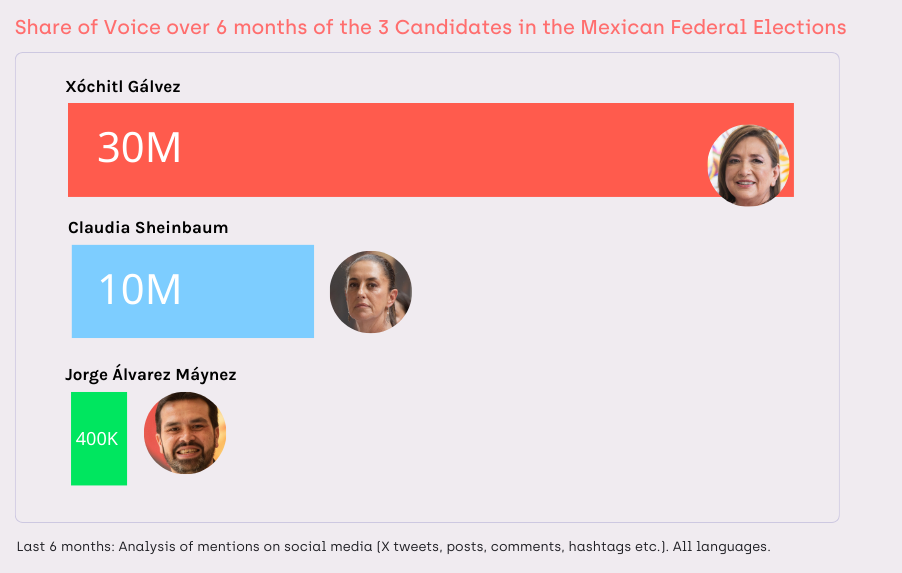
In the end, Claudia Sheinbaum won the election and received between 58.3% and 60.7% of the vote, according to an estimate by the National Electoral Institute’s president.
But does the share of voice on social media reflect the voting intention results in the polls and the final election results? This is a valid question for every election. The answers vary according to each election and the performance of the communities and resources committed to social media by the campaign teams. In the case of the Mexican election, over the last 6 months, Xóchitl Gálvez, had 3 times more social media mentions than poll favorite, Claudia Sheinbaum, i.e. 30 million vs. 10 million.
There are several reasons for this:
- Social media users tend to talk more about the opposition: Xóchitl Gálvez represents the main group competing against the alliance led by the current president with Claudia Sheinbaum at the helm.
- Secondly, Gálvez attracts a larger community on social networks; the number of people publishing messages about her is 3 times greater than for her competitor.
2. Campaign topics
The issues most associated with the 2 leading candidates are:
- The healthcare system
- Corruption
- Education
- Organized crime
Surprisingly, the topic of migration only came in 7th place, despite the fact that national and international media highlighted it as a major campaign issue.
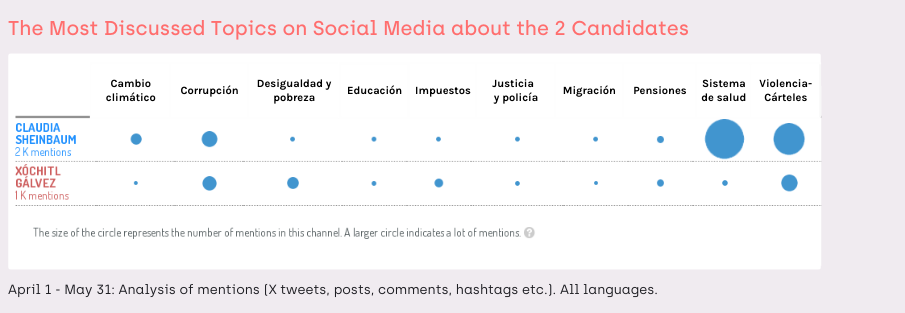
B. 2024 European Elections (June 6 – 9), view from France
1. In the Media
In traditional media, the visibility of the 2024 European elections in France is almost 30% lower than in 2019. Using our media measurement tools, we were able to see that the European election campaign generated a 7,147 Media Noise Unit (UBM) as well as 4,715 mentions (TV/radio subjects and published articles) in 2019. Compared to a 5,030 UBM and 3,647 mentions in 2024.
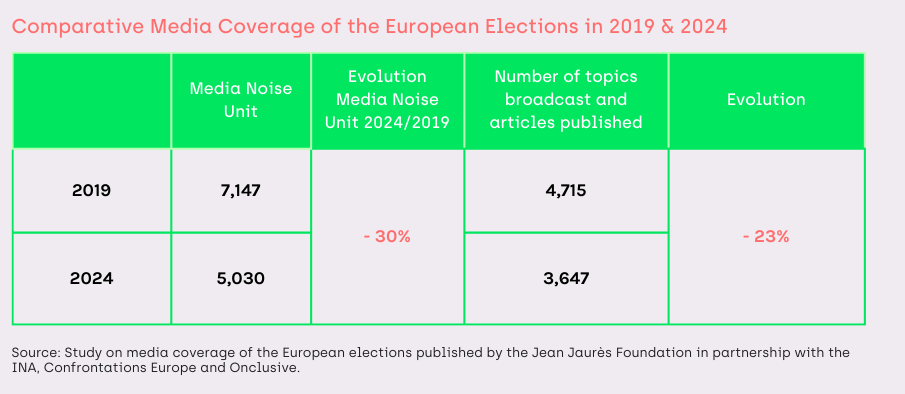
This is one of the findings from the study on media coverage of the European elections. Published by the Fondation Jean Jaurès in partnership with INA, Confrontations Europe, and Onclusive.
(1) ONCLUSIVE’s UBM (Media Noise Unit) barometer measures the media impact of topical issues, companies and personalities on a panel of 120 sources. It has a representative corpus of the leading media in terms of general public audience in France, taking into account the most powerful print and online media and the TV and radio time slots that generate the most contacts. It enables us to measure the intensity of media pressure and monitor changes in it as closely as possible to real time. With 100 UBM, it’s as if every French person aged 15 and over had been exposed once to 1 page or 1 minute of information on the subject.
The data covers the period from April 1 – May 20 2024. The study covers 117 print and online press sources, newspapers, and radio and TV broadcasts, representing a total of 3,647 articles and reports over the period.
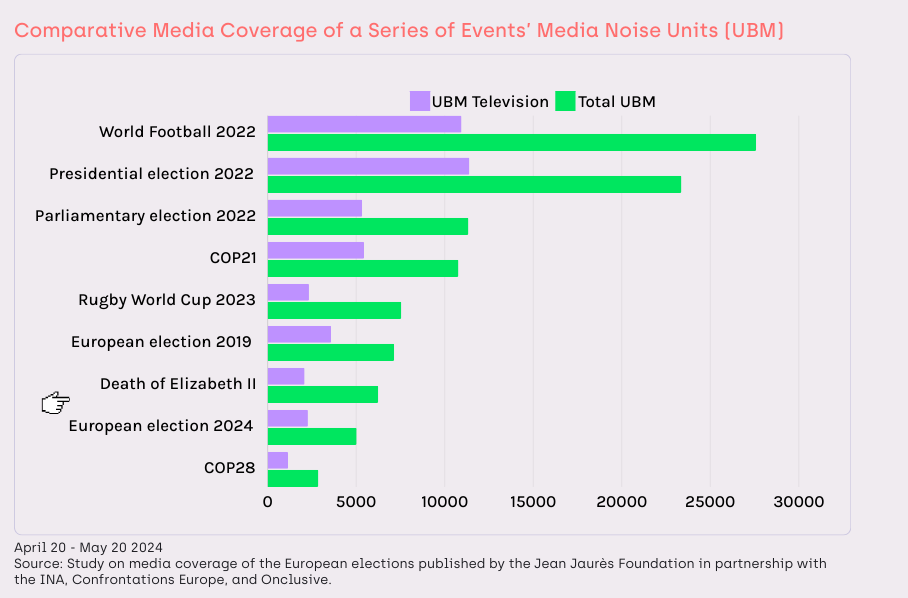
The 2024 European elections generated a 5,030 Media Noise Unit (UBM) in the 117 mainstream media monitored, including a 2,274 UBM for TV channels alone.
The European elections are often relegated to second place in the hierarchy of events covered by the mainstream French media. In comparison, football and French domestic politics dominate the media space, occupying the top spots. Even when it peaked in 2019, media coverage of the European elections only made up two-thirds (67%) of that given to the 2022 parliamentary elections.
Campaign themes in the media
News media monitoring shows that environmental issues are at the forefront of the campaign. European debates on agriculture and environmental standards account for 9% of the campaign noise. Followed by themes surrounding purchasing power, immigration, the war in Ukraine, and climate challenges, which make up 20% of the noise generated by the European election campaign in the period studied. Ukraine and immigration, each accounting for 7% of media volume, rank second and third respectively.
2. In social media
The candidates
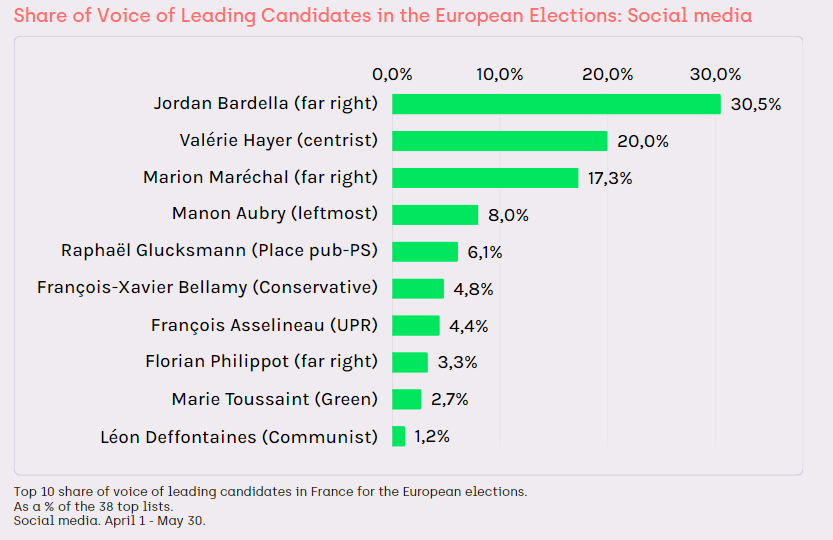
According to our social media listening tools, the candidates’ shares of voice across social media are quite different from poll rankings and more evenly distributed. So, while Jordan Bardella (RN, far-right candidate) is well ahead in the polls and in share of voice overall, Valérie Hayer (Renaissance, liberals) and Marion Maréchal (Reconquête!, far-right) have greater visibility on social media in relation to voting intentions.
Conversations on social media often pit the clear favorite – Jordan Bardella – against Valérie Hayer, seen as the candidate of the powers that be. And, far-right communities are historically very active on social media. This also explains Marion Maréchal’s high share of voice.
The biggest gap among the poll favorites concerns social democrat, Raphaël Glucksmann. Often in 3rd or even 2nd place in opinion polls, his social media share of voice sits in 5th place. It’s the nature of social media that partly explains this discrepancy. Glucksmann is less polarizing and less extreme in his statements than the far-right candidates, and less systematically opposed to the favorite, Jordan Bardella.
Campaign topics
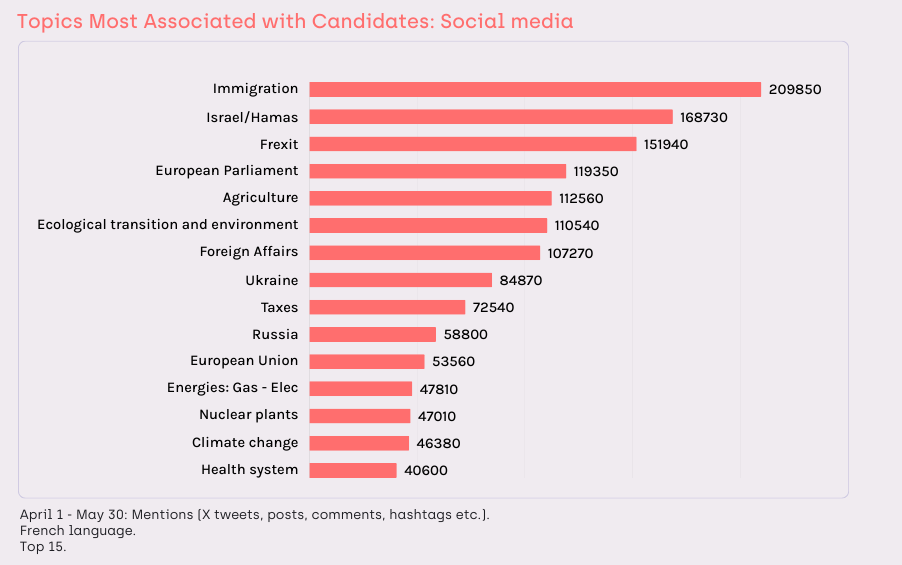
The most discussed topics surrounding the candidates on social media differ from those most highlighted by traditional media. Firstly, immigration (over 209,000 mentions), followed by the Israel/Hamas conflict, Frexit, the European Parliament, agriculture, and the ecological transition.
But how are these topics broken down by candidate?
- Marion Maréchal (far-right) stands out on the subject of immigration, with many speeches and comments on the subject.
- Manon Aubry (far left) dominates the Israel/Hamas conflict topic.
- Marie Toussaint (Greens) is logically more present on the subject of ecological transition.
The other candidates communicate more uniformly on a range of subjects (foreign affairs, agriculture/climate, taxes, Ukraine, immigration, and Hamas), with no one theme particularly standing out on social media.
C. UK General Election (July 4)
The elections were somewhat unexpected: Rishi Sunak sought to regain the upper hand by announcing early elections for July on 22 May. However, this element of surprise has so far failed to produce the desired effect. The first week of the election campaign has not altered the current trend. According to the polls, the Labour Party would get an average of 45% of the vote, while the Conservatives would get 23%, which could indicate a landslide victory for Labour.
1. In social media
Our social listening tools show that Rishi Sunak’s Conservative Party received the most mentions, not far ahead of the Labour Party. The SNP came 3rd, ahead of Reform UK. The Top 6 in terms of share of voice, reflect the voting polls (Conservative, Labour, SNP, Reform UK, Liberal Democrats and the Green Party), but not in the same order. This is mainly due to social media criticism of the Conservative party, which is boosting its volume of mentions.
The Scottish National Party’s (SNP) 3rd place highlights the tense discussions on social media about its campaign for Scottish independence from the UK.
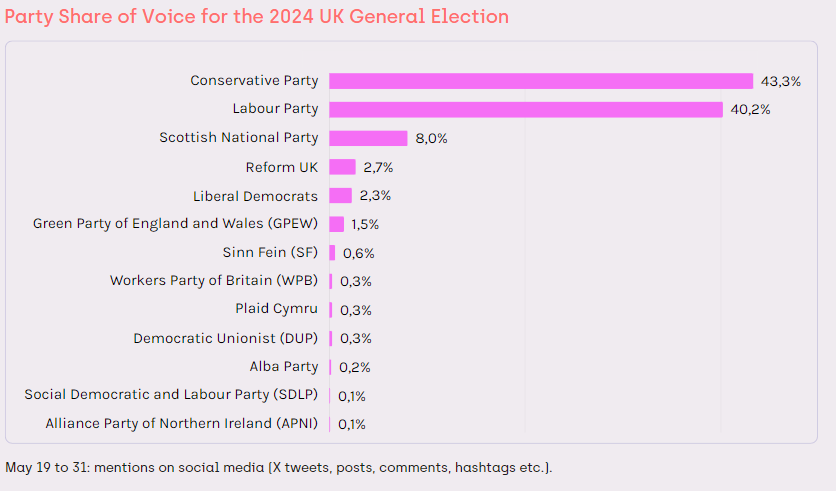
The most talked about topics
- Compulsory National Service was the subject that generated the most reactions. There was a clear spike in mentions on May 26 when Rishi Sunak announced that he would reinstate National Service if he won the July general election. The spike has since subsided.
- In contrast, conversations about the Israel/Hamas conflict, immigration, the NHS, and Brexit are regular and ongoing on social media in relation to the general election.
- Labour Party leader, Keir Starmer, stands out from Rishi Sunak on social media on 2 topics that generate a lot of volume: the cost of energy for British households and criticism of his position on the Israel/Hamas conflict.
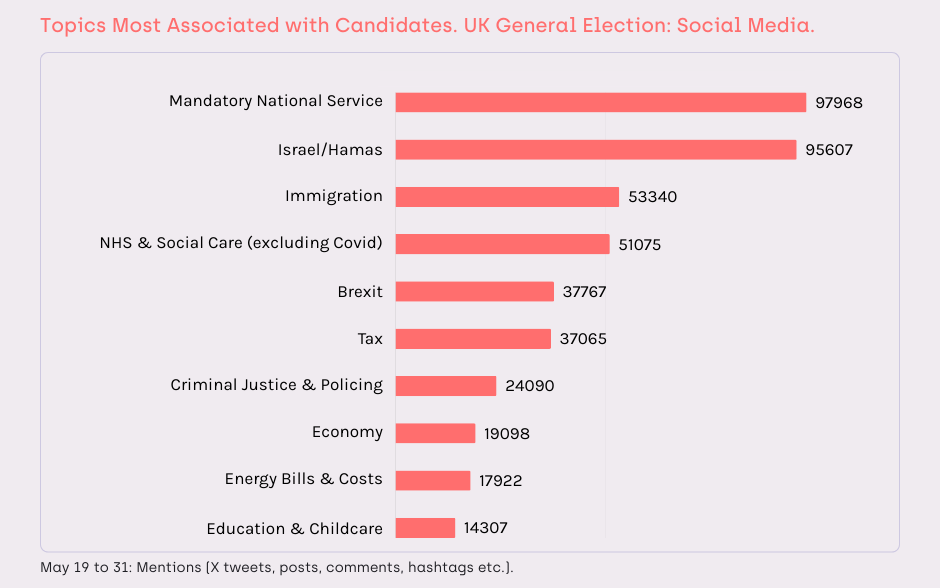
2. In the media:
To find out more about political communications, media tactics, and the UK general election, tune into the Politicomms podcast: For communications professionals, by communications professionals.
D. US presidential elections (November 5)
Since October 2023, we’ve been scrutinizing the US election through the lens of traditional and social media. Let’s take a look at some of the lessons learned in the first quarter (Q1) of 2024:
1. In the media
As the new year arrived, 2024 brought with it an increase in presidential campaign coverage. Super Tuesday, primaries, caucuses, and the State of the Union address drove coverage throughout Q1 of 2024.
Our media measurement tools show that the candidate field narrowed considerably as Haley, DeSantis, Hutchinson, Ramaswamy, Christie, and Phillips dropped out of the race. Williamson’s campaign suspension and subsequent unsuspension temporarily lifted her coverage volume.
Kennedy’s volume also temporarily increased in March as speculation swirled about a potential VP running mate.

2. In social media
- During Q1, there were more than 3.36 million online mentions relating to ‘US elections’, ‘Republicans’ and ‘Democrats’. This is a significant increase (+13%) compared to Q4 of 2023 (2.97 million mentions).
- When all of the conversations about Republican, Democrat, Green, Libertarian, and Independent candidates are aggregated, the volume of conversations totals 10.1 million mentions, up 4.1% on Q4 2023.
- As in Q4 2023, the Democrats received more mentions than the Republicans, mainly due to Joe Biden’s weight as President. Super Tuesday, the Supreme Court decisions, the State of the Union Address, and tensions at the Mexican border caused this increase in conversations.
Key topics driving these Q1 conversations about Democrats include:
- Border control and immigration
- Israel/Hamas conflict
- Healthcare
- Economy
- Taxes
Topics surrounding the Republicans are largely the same, with some differences:
- Climate change doesn’t feature in the Top 10 discussions about the Republicans.
- Criticism of aid to Ukraine is important.
- The topic of foreign affairs is represented mostly through criticism of its excessive importance for Biden in comparison to his focus on domestic policy.
3. Focus topic: The “Uncommitted” – Media impact score and social listening
The “Uncommitted” Movement in the media
News coverage about uncommitted voters will likely ebb and flow over 2024 as the presidential election heats up. Coverage about these voters is currently most featured in moderate and left leaning publications. However, if Kennedy and Williamson continue in the presidential race, this may change as votes are drawn away from both parties.
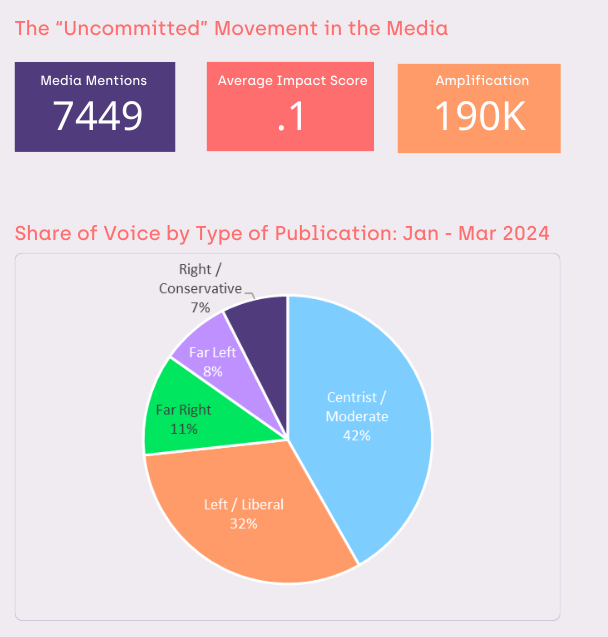
Amplification
Social media shares of earned, owned, and newswire coverage from Facebook, Twitter, and Pinterest.
Impact Score
The Impact Score is a qualitative article metric that combines the “three Rs” (relevance, reputation, and repetition) and sentiment into a single measurement that allows quick benchmarking for both competitive and non-competitive scenarios alike.
The “Uncommitted” Movement on social media
The “Uncommitted” movement has been gaining momentum on social media since mid-February. It started in Michigan – a key battleground state and home to one of the largest Arab American populations in the US.
The campaign is growing to vote “uncommitted” in the state’s Democratic Primary, in protest of Biden’s policies that back Israel. The peak of mentions were seen on polling day in Michigan, (February 27) followed by two peaks around Super Tuesday. But the call for an “uncommitted” vote from Democrat voters goes back to January, on X (Twitter) in particular. The messages were posted and relayed well beyond the Arab-Muslim community, with politicians, actors, and ordinary citizens all taking part in the campaign.
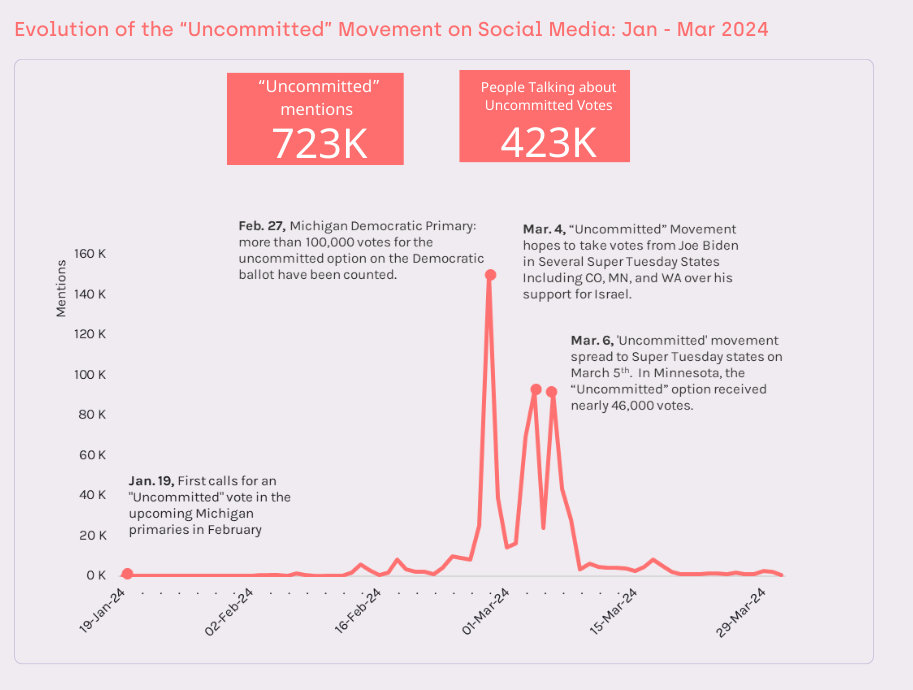
To delve into more detail about mainstream and social media coverage of the US Election Campaign, download our latest US Election report. It combines data from our media monitoring and measurement tools, social listening, and AP Planning platforms to give you an up-to-date analysis of the campaign so far.
III. What you need to know about elections in the media and social media
What do you learn from news monitoring, media measurement, and social listening?
- The 4 elections analyzed have one thing in common: they are largely impacted by foreign policy and international affairs. Migrants, immigration, borders, conflicts, and international tensions are prominent campaign topics that influence candidates’ proposals.
- As with other news topics, there are 2 types of election-related stories:
- Either they are first reported in the traditional media and then commented on and amplified in the social media. E.g. Trump’s concealed payment scandals.
- Or they originate on the web and social media and are then reported on in the media. For example: The ‘Uncommitted’ movement in the USA from January 2024.
- Share of voice on social media does not necessarily correspond to voting intention trends in the opinion polls. Rather, it depends on a number of factors such as a party and its candidate’s investment in social media, their charisma, behavior, age of their potential voters, and their messaging (polemical, polarizing, technocratic, popular, etc.). So, the number of followers a candidate has on social media is not as important as you might assume. Some candidates with fewer followers generate better engagement rates than their competitors due to the topics and content they choose to discuss and the activism of their social media communities.
- On the other hand, social media provides valuable information about voters’ perceptions of candidates and the issues that interest them most. These may differ significantly from the issues highlighted by the media. This is the case for Marion Maréchal in France, for example, or the issue of immigration in the European elections, which received a greater share of voice on social media than in the media.
- Shares of voice on social media often favor the opposition candidate over a candidate from or assimilated to the government in place. The extreme pattern is the case of Donald Trump who positions himself as a victim of the Biden Administration and boosts his visibility and his social media engagement via his communities of “defenders”.
Learn more about our media monitoring tools and how they can provide critical insights for your strategies. Contact us for a demo.
